七年级英语第四单元教案
- 格式:doc
- 大小:24.00 KB
- 文档页数:6
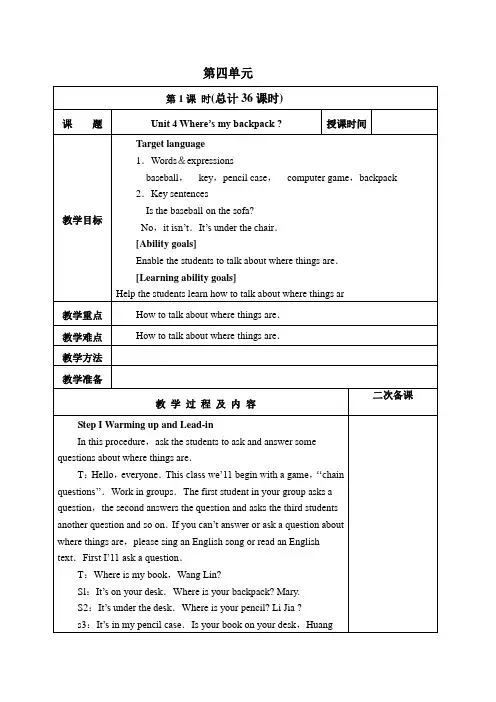

英语七年级上册第四单元英语七年级上册第四单元教案教学目标:1.知识目标:学生能够掌握本单元的词汇和基本句型。
2.能力目标:学生能够运用所学知识进行简单的日常对话和交流。
3.情感目标:培养学生对英语学习的兴趣,增强跨文化交流的意识。
教学内容:1.词汇:掌握与单元主题相关的词汇。
2.基本句型:学习并掌握重点句型。
3.对话与短文:理解并能够口头复述。
教学难点与重点:1.重点:掌握重点词汇和句型,能够在实际情境中运用。
2.难点:如何引导学生理解对话和短文中的文化差异,并正确运用所学知识进行跨文化交流。
教具和多媒体资源:1.投影仪:展示PPT,帮助学生理解课文内容。
2.教学卡片:用于词汇的操练。
3.图片:展示西方文化元素,帮助学生了解西方文化背景。
4.音频设备:播放课文录音。
教学方法:1.激活学生的前知:提问学生关于本单元主题的了解情况。
2.教学策略:通过讲解、示范、小组讨论和角色扮演等方式进行教学。
3.学生活动:小组内进行句型操练,角色扮演对话。
教学过程:1.导入:通过播放与本单元主题相关的视频,激发学生的兴趣。
2.讲授新课:讲解词汇、句型,播放课文录音,学生跟读。
同时使用投影仪展示PPT。
3.巩固练习:小组内进行句型操练,角色扮演对话。
然后通过游戏、角色扮演等方式巩固所学内容。
4.归纳小结:总结本单元的重点内容,强调实际运用的重要性。
同时对学生的学习情况进行反馈。
5.布置作业:要求学生写一篇短文,介绍自己对西方文化的认识和感受。
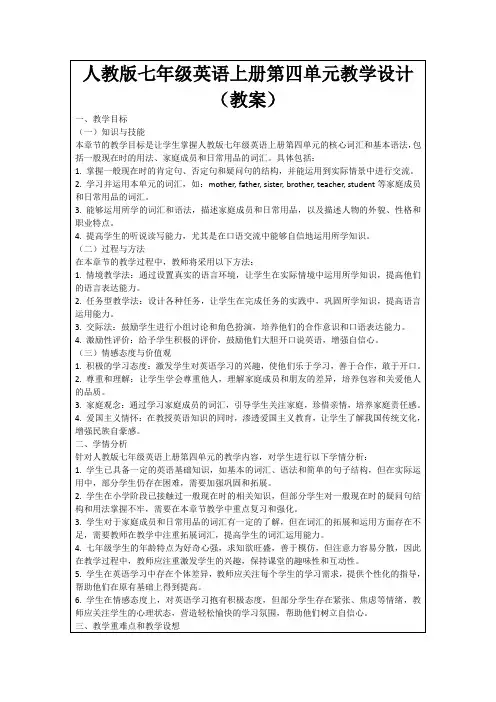
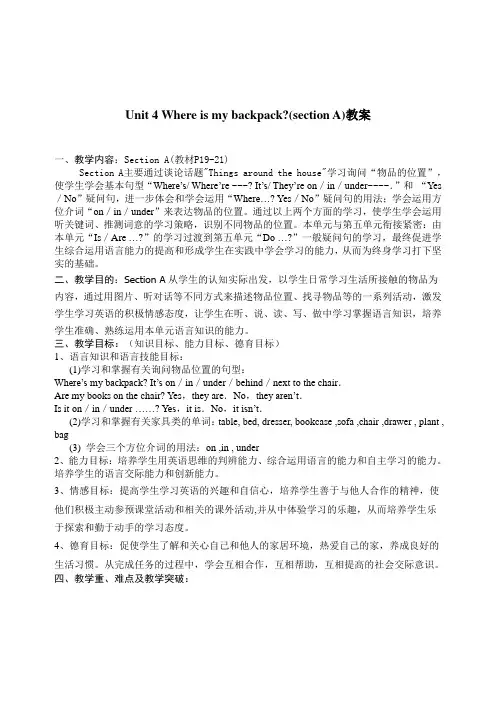
Unit 4 Where is my backpack?(section A)教案一、教学内容:Section A(教材P19-21)Section A主要通过谈论话题"Things around the house"学习询问“物品的位置”,使学生学会基本句型“Where’s/ Where’re ~~~? It’s/ They’re on/in/under~~~~.”和“Yes /No”疑问句,进一步体会和学会运用“Whe re…? Yes/No”疑问句的用法;学会运用方位介词“on/in/under”来表达物品的位置。
通过以上两个方面的学习,使学生学会运用听关键词、推测词意的学习策略,识别不同物品的位置。
本单元与第五单元衔接紧密:由本单元“Is/Are …?”的学习过渡到第五单元“Do …?”一般疑问句的学习,最终促进学生综合运用语言能力的提高和形成学生在实践中学会学习的能力,从而为终身学习打下坚实的基础。
二、教学目的:Section A从学生的认知实际出发,以学生日常学习生活所接触的物品为内容,通过用图片、听对话等不同方式来描述物品位置、找寻物品等的一系列活动,激发学生学习英语的积极情感态度,让学生在听、说、读、写、做中学习掌握语言知识,培养学生准确、熟练运用本单元语言知识的能力。
三、教学目标:(知识目标、能力目标、德育目标)1、语言知识和语言技能目标:(1)学习和掌握有关询问物品位置的句型:Where’s my backpack? It’s on/in/under/behind/next to the chair.Are my books on the chair? Yes,they are.No,the y aren’t.Is it on/in/under ……? Yes,it is.No,it isn’t.(2)学习和掌握有关家具类的单词:table, bed, dresser, bookcase ,sofa ,chair ,drawer , plant , bag(3) 学会三个方位介词的用法:on ,in , under2、能力目标:培养学生用英语思维的判辨能力、综合运用语言的能力和自主学习的能力。

七年级上册第四单元教案:让学生全面认识英语语法知识让学生全面认识英语语法知识英语语法学习是学好英语的基础,随着外语教学水平的提高,语法教学也越来越受到重视。
英语语法知识的掌握对于学生的英语学习和应用有着至关重要的作用。
七年级上册第四单元就是英语语法知识的重点学习阶段,这里有一份详细的教案,旨在帮助老师和学生更好地掌握英语语法知识。
一、教学目标1.了解英语句子的基本构成和结构,掌握基本的语法知识。
2.认识和掌握英语句子中的各种成分和语法规则,包括主语、谓语、宾语等。
3.能够辨别各种句子类型,如陈述句、疑问句、祈使句等。
4.通过举例、练习等方式,提高学生英语句子组织和表达的能力。
二、教学内容及方法1.英语句子的结构和构成教学内容:英语句子包括主语、谓语、宾语、表语、补语等成分。
主语通常是句子的中心,可以是一个名词、代词、数词、不定式或一从句。
谓语是指句子中表达动作或状态的动词,宾语是动词的宾语,表语和补语是指从句或其他部分为补语或表语。
教学方法:老师可以通过讲解和案例分析的方式,让学生了解英语句子的基本构成,并且将其分解成各种成分,详细讲解其含义和功能。
通过举例说明,让学生了解不同成分在英语句子中的用法和表达方式。
2.英语句子的类型教学内容:英语句子按照语调和语气的不同,可以分为陈述句、疑问句和祈使句等类型。
不同类型的英语句子有不同的表达方式和语法结构。
教学方法:通过讲解不同类型的英语句子的语调和语气,让学生能够正确分析句子类型,并能够准确地使用不同句子类型表达不同意思。
如通过讲解陈述句的特点和结构,让学生能够正确理解和使用陈述句。
3.主谓一致教学内容:主谓一致是英语语法中一项重要的规则,指主语和谓语在人称和数上保持一致。
如果主语是单数,那么谓语也要使用单数;如果主语是复数,那么谓语也要使用复数。
这是英语语法中一个比较简单的知识点,但是在使用过程中经常出现错误。
教学方法:通过讲解和练习巩固的方式,让学生理解主谓一致的规则和操作方法。
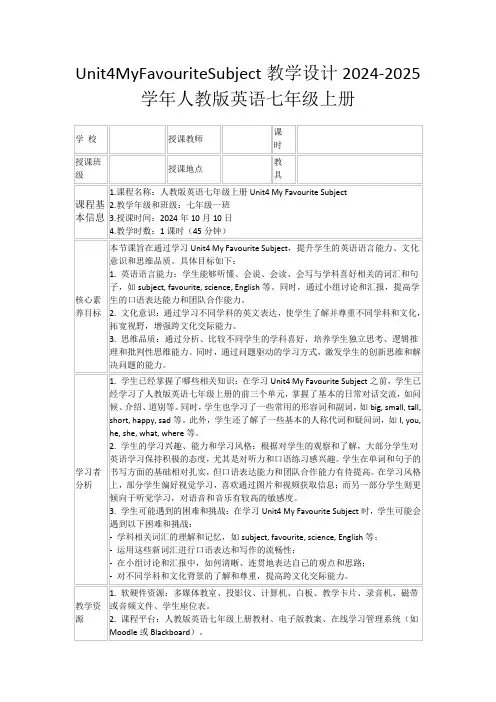
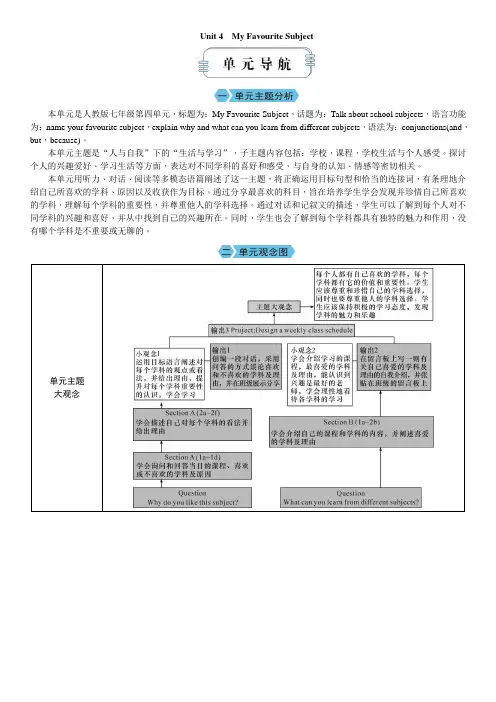
Unit 4 My Favourite Subject本单元是人教版七年级第四单元,标题为:My Favourite Subject,话题为:Talk about school subjects,语言功能为:name your favourite subject,explain why and what can you learn from different subjects,语法为:conjunctions(and,but,because)。
本单元主题是“人与自我”下的“生活与学习”,子主题内容包括:学校,课程,学校生活与个人感受。
探讨个人的兴趣爱好、学习生活等方面,表达对不同学科的喜好和感受,与自身的认知、情感等密切相关。
本单元用听力、对话、阅读等多模态语篇阐述了这一主题,将正确运用目标句型和恰当的连接词,有条理地介绍自己所喜欢的学科、原因以及收获作为目标。
通过分享最喜欢的科目,旨在培养学生学会发现并珍惜自己所喜欢的学科,理解每个学科的重要性,并尊重他人的学科选择。
通过对话和记叙文的描述,学生可以了解到每个人对不同学科的兴趣和喜好,并从中找到自己的兴趣所在。
同时,学生也会了解到每个学科都具有独特的魅力和作用,没有哪个学科是不重要或无聊的。
单元主题大观念单元语言大观念语言能力及技能语言能力:1.掌握与学科相关的词汇和常用表达,如:magic,useful,fun,important,subjects,difficult,easy,Chinese,history,maths,English,music,PE,geography,biology,IT,art,learn about the past,help me with my maths,work out maths problemsKey sentences:①—What's your favourite subject?—My favourite subject is…②—Why do you like…?—Because it's…③I'm good with numbers.④I'm not good at science.2.掌握双元音/e/,/a/,//,/əu/,/au/,/ə/,/eə/,/uə/的字母组合发音和单词连读。
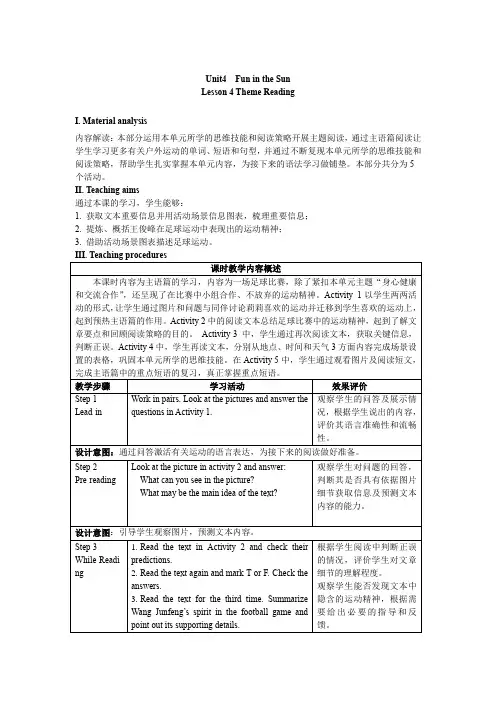
Unit4 Fun in the Sun
Lesson 4 Theme Reading
I. Material analysis
内容解读:本部分运用本单元所学的思维技能和阅读策略开展主题阅读,通过主语篇阅读让学生学习更多有关户外运动的单词、短语和句型,并通过不断复现本单元所学的思维技能和阅读策略,帮助学生扎实掌握本单元内容,为接下来的语法学习做铺垫。
本部分共分为5个活动。
II. Teaching aims
通过本课的学习,学生能够:
1. 获取文本重要信息并用活动场景信息图表,梳理重要信息;
2. 提炼、概括王俊峰在足球运动中表现出的运动精神;
3. 借助活动场景图表描述足球运动。
IV. Blackboard design。
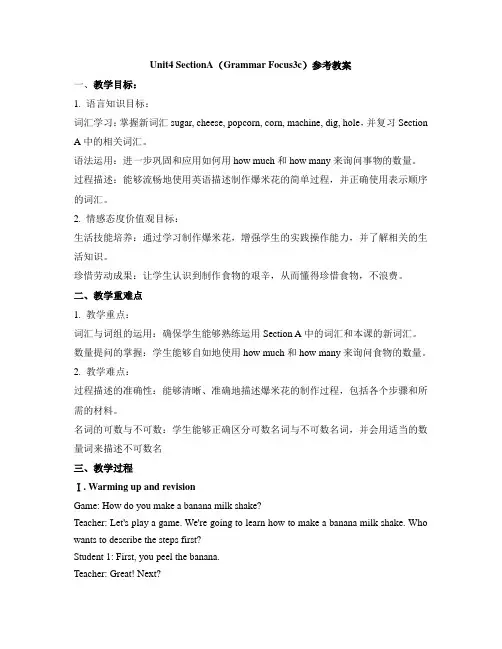
Unit4 SectionA(Grammar Focus3c)参考教案一、教学目标:1. 语言知识目标:词汇学习:掌握新词汇sugar, cheese, popcorn, corn, machine, dig, hole,并复习Section A中的相关词汇。
语法运用:进一步巩固和应用如何用how much和how many来询问事物的数量。
过程描述:能够流畅地使用英语描述制作爆米花的简单过程,并正确使用表示顺序的词汇。
2. 情感态度价值观目标:生活技能培养:通过学习制作爆米花,增强学生的实践操作能力,并了解相关的生活知识。
珍惜劳动成果:让学生认识到制作食物的艰辛,从而懂得珍惜食物,不浪费。
二、教学重难点1. 教学重点:词汇与词组的运用:确保学生能够熟练运用Section A中的词汇和本课的新词汇。
数量提问的掌握:学生能够自如地使用how much和how many来询问食物的数量。
2. 教学难点:过程描述的准确性:能够清晰、准确地描述爆米花的制作过程,包括各个步骤和所需的材料。
名词的可数与不可数:学生能够正确区分可数名词与不可数名词,并会用适当的数量词来描述不可数名三、教学过程Ⅰ. Warming up and revisionGame: How do you make a banana milk shake?Teacher: Let's play a game. We're going to learn how to make a banana milk shake. Who wants to describe the steps first?Student 1: First, you peel the banana.Teacher: Great! Next?Student 2: Next, you put the banana into the blender.Teacher: And then?Student 3: Then, you pour the milk into the blender.Teacher: Finally?Student 4: Finally, you turn on the blender and mix it well.Teacher: Very good! Remember to use "first, next, then, finally" correctly when describing processes.How do you make a Russian soup?Teacher: Now, let's try with a different recipe. How do you make a Russian soup? Student 5: First, you heat the water.Teacher: And?Student 6: Next, you add the vegetables and meat.Teacher: Continue...Student 7: Then, you let it boil for a while.Teacher: And finally?Student 8: Finally, you add salt and pepper to taste, and serve it hot.Teacher: Excellent! Remember, using "first, next, then, finally" helps make instructions clear and easy to follow.Ⅱ. Grammar Focus.1. 学生阅读Grammar Focus中的句子,然后做填空练习。
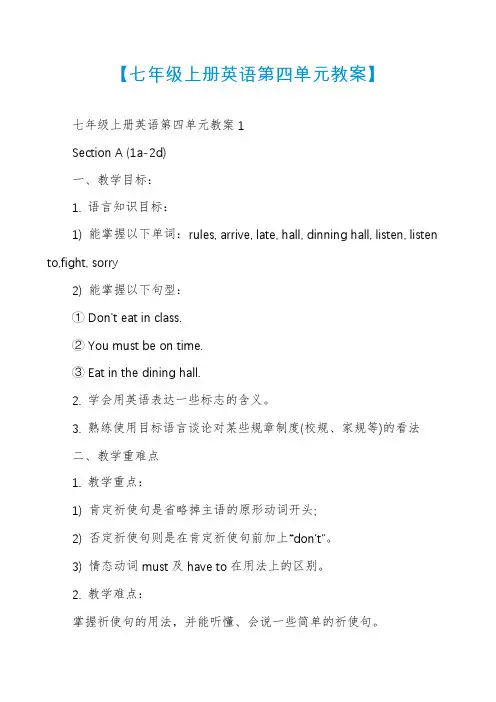
【七年级上册英语第四单元教案】七年级上册英语第四单元教案1Section A (1a-2d)一、教学目标:1. 语言知识目标:1) 能掌握以下单词:rules, arrive, late, hall, dinning hall, listen, listen to,fight, sorry2) 能掌握以下句型:① Don't eat in class.② You must be on time.③ Eat in the dining hall.2. 学会用英语表达一些标志的含义。
3. 熟练使用目标语言谈论对某些规章制度(校规、家规等)的看法二、教学重难点1. 教学重点:1) 肯定祈使句是省略掉主语的原形动词开头;2) 否定祈使句则是在肯定祈使句前加上“don’t”。
3) 情态动词must及have to在用法上的区别。
2. 教学难点:掌握祈使句的用法,并能听懂、会说一些简单的祈使句。
三、教学过程Ⅰ. Warming-up and revision用祈使句请学生们完成一系列动作:Please stand up/ sit down. Close the door, please. Look at me and listen tome.Don’t open your books. Don’t talk. Let’s begi n our class.Ⅱ. 1aT: Now, Look at the picture on your textbook. Each of the students isbreaking one of these rules. Please finish 1a.Ⅳ. ListeningNow let’s listen! What rules are these students breaking? Write the numbersafter names?Ⅴ. Pair workRead the dialogue in 1cand work in pairs.Ⅵ. Listening1. First, let's read the sentences in 2a together. Now, let's listen to therecording. Check the activities Alan and Cindy talk about.2. Work on 2b: Listen to the recording again. Can Alan and Cindy do theseactivities? Circle can or can't above.Ⅶ. Pair work1. Suppose you are Alan and your partner is Cindy. Talk about the rules in2a.2. Let some students e to the front and act out the conversations.Ⅷ. Role-playRead the conversation and find some rules in this school. Ss read theconversations and find the answers to this question.( Don't be late for school. Don't bring music players to school. You alwayshave to wear the school uniform. You have to be quiet in the library. )Homework:1. Remember the new words and expressions.2. 完成下列句型转换试题1)I can play puter games on weekends.(一般疑问句)_________________________________? Yes, ____________.2) He has to wear uniform.(变否定句) He _____ _____ _____ wear uniform.3) I have to wear sneakers for gym class.(一般疑问句)_____ you ____ ____ wear sneakers for gym class? Yes, I ____.4) They have to wash clothes.(提问) ____ do they have ____ ____?5) You can’t go out on school nights.(换一种表达) _______ go out on schoolnights.6) Don’t talk in class.(同上) No _________.Section A (Grammar Focus-3c)教学重难点1. 教学重点:1) 继续学习使用目标语言谈论对某些规章制度(校规、家规等)的看法2) 通过不同方式的练习方式来学会用英语表达一些标志的含义。
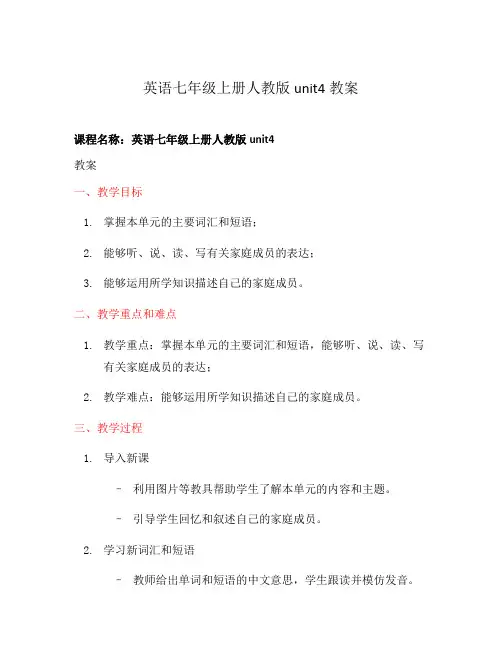
英语七年级上册人教版unit4教案课程名称:英语七年级上册人教版unit4教案一、教学目标1.掌握本单元的主要词汇和短语;2.能够听、说、读、写有关家庭成员的表达;3.能够运用所学知识描述自己的家庭成员。
二、教学重点和难点1.教学重点:掌握本单元的主要词汇和短语,能够听、说、读、写有关家庭成员的表达;2.教学难点:能够运用所学知识描述自己的家庭成员。
三、教学过程1.导入新课–利用图片等教具帮助学生了解本单元的内容和主题。
–引导学生回忆和叙述自己的家庭成员。
2.学习新词汇和短语–教师给出单词和短语的中文意思,学生跟读并模仿发音。
–利用图片和实物等教具帮助学生理解和记忆新词汇和短语。
3.听力训练–播放相关的听力材料,让学生听并回答问题。
–分组进行听力练习,让学生互相提问并回答。
4.口语训练–设计各种情景对话,让学生进行角色扮演,练习运用所学知识进行对话。
5.阅读训练–分发阅读材料,让学生阅读并回答问题。
–设计相关的阅读任务,让学生合作阅读,并互相询问答案。
6.书面表达–让学生运用所学知识,描述自己的家庭成员。
–提供范文和写作模板,帮助学生完成作文。
7.温故知新–设计一些小游戏和测试,复习本单元的知识和内容。
四、教学评价1.通过听、说、读、写的综合训练,评价学生对本单元知识的掌握情况。
2.设计相关练习和测试,对学生的能力进行评价。
五、教学资源1.课件及相关教具;2.单词卡片、图片和实物等教具;3.听力材料、阅读材料和相关练习题;4.范文和写作模板;5.小游戏和测试题。
六、拓展阅读•推荐学生找一些有关家庭成员的英语文章进行阅读,提高阅读能力和理解能力。
七、课后作业1.背诵本单元的重点词汇和短语;2.完成相关的听力和阅读练习题;3.完成书面作业,描述自己的家庭成员。
八、板书设计•Unit 4: My Family•Vocabulary: father, mother, brother, sister,grandparents, cousin, uncle, aunt•Phrases: in front of, next to, between, on the left/right of九、教学反思根据学生的实际情况和进度,灵活调整教学策略和教学内容。
精选】人教版七年级下册英语Unit4第四单元优秀教案Unit 4 Don't Eat in Classn A (1a-1c)XXX:1.Key words: rule。
arrive。
hallway。
hall。
listen。
fight。
sorry.2.Key phrases: in the dining hall。
listen to。
on time.3.Key sentence structures:What are the rules?Well。
we can't arrive late for school。
We must be on time.Don't listen to music in class.Focus of Learning:1.XXX.e of imperative sentences.Difficulties:Use of imperative sentences.Self-Study:1.Preview the new words on page 19 and memorize them。
Translate the following Chinese words into English:规定: rule到达: arrive走廊: XXX大厅: hall倾听: listen打架: fight抱歉的: sorry2.Carefully preview 1a。
1b。
and 1c and XXX:What are the rules?We can't arrive late for school!We must be on time!Don't listen to music in class!XXX.In-Class Guidance:Step 1: nShow the students a picture and ask them XXX of "What ishe/she doing?"XXX: Look at this girl。
Unit 4 Where's my schoolbag?Section A (1a-1c)一、教学目标:1. 语言知识目标:1) 能掌握下列词汇:where, table, bed, bookcase, sofa, chair, on, in, under2) 学会运用方位介词in, on, under和where句型表述物品所在的位置。
3) 能掌握以下句型:①—Where's…? —It's in/on/under…②—Where are…? —They're in/on/under…2. 情感态度价值观目标:培养学生整齐地摆放自己物品的生活习惯。
在描述物品的位置的学习中获得英语学习的乐趣,逐步培养学生们对英语学习的兴趣。
二、教学重难点1. 教学重点:1) 方位介词in , on , under的用法。
2) Where的特殊疑问句2. 教学难点:1) 学会正确描述物品作在的位置;2) 学会询问自己或他人物品的具体位置;三、教学过程Ⅰ. Warming-up and revision1、G reeting2、Game :guess some things that the teacher hid just now.(An orange, a phone, an ID card, ,a ping pong ball ,a schoolbag, a watch )3、Watch a video (in on under)Ⅱ. Presentation1. Present the furnitureT: Look at the big picture on the screen. This is a big nice room. I want to own such a room. Because there is some nice furniture in it. Do you know the names of the furniture?(Show a picture of a bed and a bookcase.)T: What’s this? It’s a bed. “BED”. Read after me. B-E-D, bed.S s: B-E-D, bed.T: What’s this? It’s a sofa. S-O-F-A, sofa.S s: S-O-F-A, sofa.(Teach the other words bookcase /table/chair/desk/hat/head in the same way.)2. Present in/ on/ underT: Where is my book? It’s on the desk. (Put a book on the desk.)S1: It’s on the desk.T: Where is my book? It’s on the desk. (To all the students.)Ss: It's on the desk.T: Where is my pen? It’s in the pencil case. (Put a pen in the pencil case and ask.)S1: It’s in the pencil box.T: Where is my pen? (To all the students.)S s: It’s in the pencil box.T: Where is my schoolbag? (Put a schoolbag under the desk and ask this question.)S1: It's under the desk.T: Where is my schoolbag? (To all the students)S s: It’s under the desk.Write "in, on, under" on the blackboard.3. Game:let the Ss see the game,then say the wordsⅢ. Listening1. Let Ss listen to the tape and finish 1b.2. Ss listen to the tape and number the things [1-4]in the picture.3. Check the answers with the class.Ⅳ. Pair work1. Practice the conversation in 1a with your partner.2. Ss practice the conversation. Then ask some pairs to act out the conversation.3. Then make your own conversations using the words in the box (in/ on/ under).Ss may look at the picture in 1a and make their own conversations. They can also using school things around them to make their own conversations.4. Ask some pairs to act out their conversations.Ⅴ. PracticeLet the Ss look at the picture,then finish the exercises:Make your own conversations by using where and on/ in/under.(看图用where和on/in/under写出3到5句话来描述你房间)For example: My schoolbag is under the table. My pens are in the pencil box.This is my bedroom.5.看图填空(1)Where__________(be) my computer game ?It’s ____________ the table.(2)Where ____________(be) my keys?They’re____________ the table.四板书设计:Unit4 Section A (1a-1c)Where’s my schoolbag?--Where +be +主语?(单/复数形式保持一致)Where’s= Where is--主语+be+{on in under }+限定词(the/某人的)+名词Where’s(Where is) my pen? It’s ( It is) on the table.Where are my pens ? They’re (They are ) under the chair五、课堂小结Where’s(Where is)….? It’s in/on/under…Where are……? They are in/on/under….六、作业布置1. Write 5 sentences to describe the location of the things in you room by usingwhere/in/on/under.(写5个句子来描述你房间的物品摆放位置)2. Help your parents to tidy the house。
七年级上册英语Unit 4集体备课教案一、教学目标通过本节课的教学,学生将能够: - 理解并掌握单词与词组:favorite, subject, among, changed, member, interesting, boring, dictionary, difficult, geography, history, mathematics, science, P.E. - 用英语谈论自己的兴趣和喜好。
- 学会正确运用介词among。
- 按照正确的语音、语调朗读对话。
- 运用所学知识进行日常交流。
二、教学重点•掌握单词和词组。
•掌握用among造句。
三、教学难点•运用所学知识进行日常交流。
四、教学准备•教学课件。
•学生练习册。
五、教学过程1. 导入新课(教师出示图片或物品,引发学生兴趣)教师:Today we are going to learn Unit 4. Can you guess what we are going to talk about in this unit?学生:…教师:Yes, we will talk about our favorite subjects. What is your favorite subject?学生:…2. 学习新知教师:Now let’s learn some new words and phrases.(教师出示PPT,依次呈现单词和词组,并进行读音示范)教师:Please repeat after me.学生:…教师:Good job!3. 情景演练教师:Let’s practice using the new words in everyday situations. I w ill give you some sentence prompts, and you can take turns to complete the sentences using the words we just learned.示例对话:教师:What’s your favorite subject?学生1:My favorite subject is mathematics.教师:Why do you like mathematics?学生1:Because it’s interestin g and challenging.教师:Good job! Next, who would like to share their favorite subject?学生2:…4. 语法讲解教师:Now let’s learn how to use the word。